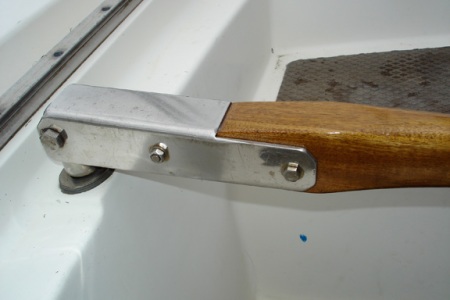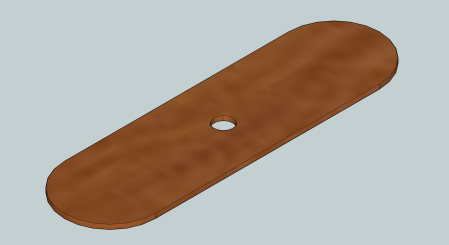Woodwork
There is a fair amount of exterior and interior woodwork in Corribees and Coromandels. Much of the interior is fitted out with varnished mahogany-faced plywood, along with a variety of hardwoods for the framing. Exterior wood (e.g. handrails, hatch slides, rubbing strakes etc.) is almost always iroko. If you are replacing any of the solid wood, iroko is obviously a good choice as it is as durable as teak and less expensive. It is, however, not so nice to work with – the dust is an irritant and the wood can warp out of shape after machining.
The models below are scale models built with the free version of the CAD software Google SketchUp. If you click on the static pictures, you can download a 3D PDF file which allows you view the object from all sides and make measurements. Please note that you will need to use the latest version of AdobeAcrobat Reader to view 3D PDFs. Third party PDF viewers such as Preview supplied with Mac OS X typically can not view 3D PDFs.
Overview
The diagram below shows where the individual parts listed on this page are installed.
Mk2 Corribee
Please note that while the dimensions of the parts in the overview diagram below are accurate, the positioning of the parts is approximate at the moment.
Exterior
Coach roof long grab handles
These are usually made from iroko.
Cockpit surround
Mk 1 only. Measurements of this item required for modeling. If you are able to provide these measurements we would be very grateful.
Companionway grab handles
These are usually made from iroko.
Companionway hatch handle
This is made of hardwood, probably iroko.
Companionway hatch retainers and slides
The retainers are usually made from iroko. The slide itself is a 1.8 mm thick composite material, possibly some sort of Tufnol. A good substitute if you’re refurbishing them would be Formica, which can be bonded to the wood with epoxy resin. Please note that the model below is of replacement parts which are different from the original design.
sCorribee has made the following model and drawing of the original hatch slider profile.
Cross-section of slide:
The diagram below shows a cross section of the arrangement of the hatch in the runner, more or less to scale. The hatch is actually quite a loose fit in the slides, with around 2 mm to 4 mm clearance around the mouldings. I suspect it varies between boats as well! Overall length is 1058 mm, large radius at each end is approximately 25 mm, and the small radius along the top edges is around 3 mm. The best way to position the slides is to dry-fit the whole lot together so that it looks right, then use a couple of small woodscrews fitted from inside just to locate them (there are typically already some holes in the coachroof where the originals were fitted). Mine seem to be through-bolted with countersunk 6 mm machine screws, nuts and penny washers on the inside, with iroko plugs to cover the m/c screw heads.

The photo shows what this arrangement looks like for real:

Hatch slide detail
Incidentally, if you’re doing a lot of refitting, it would be worth ordering a load of A4 fixings from somewhere like A2A4.co.uk, as they’ll be much cheaper than your local chandlery in my experience. It’s also worth buying a plug cutter and matching drill from Axminster, but you really need a pillar drill to cut the plugs.
Ensign staff
These can be made of pine or mahogany.
Fore hatch grab handles
These are usually made from iroko.
Headlining
The headlining panels are 4 mm plywood covered with some kind of material which looks like vinyl.
Rubbing strakes
These are made of hardwood, probably iroko. Please note that while the profile of the rubbing strakes in this diagram is to scale, the lengths and paths are approximate.
Tiller
This is made of hardwood, probably iroko.
Standard pattern tiller suitable for most mk 2 and mk 3 Corribees:
The drawing above is for a tiller to suit the fitting shown in the following photos:
1. A short pattern tiller in mahogany, shown here with a fitting for a Raymarine Tiller Pilot:
2, Close up of the fitting:
3. Tiller cover – to protect the varnish finish
Washboards
9 mm marine plywood. Solid wood trim, sometimes iroko or mahogany. If making new replacements it would be worth using a mahogany or teak faced marine ply, and either lipping the edges with solid wood trim or sealing with epoxy resin before varnishing. It is also worth considering making a duplicate set from cheaper Weather and Boil Proof (WBP) or even shuttering grade plywood and painting them – this second set can be used in the winter.
Upper washboard
Lower washboard
Interior
Chain locker door
The main section of the door is made out of 9 mm plywood. The handle and the tab are made from some kind of hardwood. The handle is attached with a M4 screw of unknown length. The tab is nailed to the door with two small nails.
Cooker unit
Coming soon
Cushion retainers
These are made from 9 mm plywood. They appear to be screwed onto the inner hull molding with M4 screws of unknown length. There is one short rectangle with round ends, two long rectangles with rounded ends and two that are paddle shaped.
Locker covers
These are made of 6 mm plywood.
These are made of 9 mm plywood:
Quarterberth boards
These are made of 6 mm plywood and are the same for port and starboard.
Sink unit
Coming soon
Steps
These are made of hardwood, probably iroko.
Table
Coming soon
Toilet retainer
Coming soon
Contribute
Do you have a story, information, brochure, manual, link or other relevant content that should be on this page? If so, we would be very grateful if you would leave it as a comment or email corribeeeditors@googlemail.com so we can post here – thanks!
































March 2, 2015 at 20:59 |
hi , have been looking for a decent hatch profile for days now and thankfully yours foots the bill perfectly…
thank you
Narrowboat “its the feeling”
April 9, 2010 at 13:49 |
Coromandel (x2)
Rubbing strakes are made from Iroko.
All grab handles and slides are made from Danta.
Iroko would be a better choice for hatch slides – mine have rotted out due to standing rainwater. Stay with Danta for the handles – it was chosen because it has a cross-linked grain. You’ll need to through-bolt if you use Iroko/ Teak etc.
Email me if you want measurements of the original hatch slides.
April 11, 2010 at 07:40 |
Strange – I haven’t heard of Danta before, and it’s not shown on the Robbins Timber website – is that a local name for something else? My Corribee definitely uses iroko for all the exterior woodwork including the grab handles and grab rails.
April 14, 2010 at 21:44 |
Update:
Iroko is specified on the Newbridge ‘Standard Boat Specification’ sheet, Jan.1980, for all exterior woodwork, including rubbing strakes.
(BTW, these spec sheets are on the reverse of the Newbridge Order Form.)
The Jan.1982 Specification Sheet specifies Danta for all exterior woodwork, with the exception of the rubbing strakes, which are listed as Iroko. I’d never heard of Danta before this.
Presumably Danta must confer some advantage over Iroko – otherwise, why change the spec ? Especially as Iroko is a far more common timber.
Danta’s scientific name is Nesogordonia Papaverifera, and alternative names are: Kotibe (Ivory Coast), Otutu (Nigeria), Owoe (Cameroon), Arborbo (Gabon), Kondofindo (Zaire), Naouya (Angola), Abumana, Akumaba, Epro (Ghana).
It’s listed in http://fp1.centurytel.net/amww/wood.html and
http://www.unctad.org/infocomm/anglais/timbertrop/characteristics.htm
Hope this helps/clarifies.
February 13, 2010 at 14:39 |
I have purchased a Trapper 28 but came across your web site by accident/ cross ref. All I can say is well done! What a fantistic, useful, informative, technically literate bunch Especially the woodwork input. Keep it up
J w
August 26, 2009 at 20:21 |
My hatch just slides on Tufnol strip about 1″ wide and not much thicker than formica. No woodwork under it.
August 25, 2009 at 18:26 |
YM Sep ’82 Coromandel review states that the internal woodwork is ‘varnished mahogany ply’.
August 25, 2009 at 18:10 |
These Drawings are very nice but need dimensions and details. I am in the process of making new companionway slides and to do so from the drawings is impossible. However Its a great job of rendition !!
August 25, 2009 at 18:15 |
I’m working on it. These have been built to scale using Google Sketchup and if you open the source files in Sketchup you can get all the dimensions. However, WordPress (where this blog is hosted), does not allow Google Sketchup files to be posted. This should be solved in a day or two – please be patient! By the way, are you also making the rails that the hatch slides on? If so, do you know what materials they are made out of and their dimensions? I have all the woodwork but not the rails and need their dimensions.